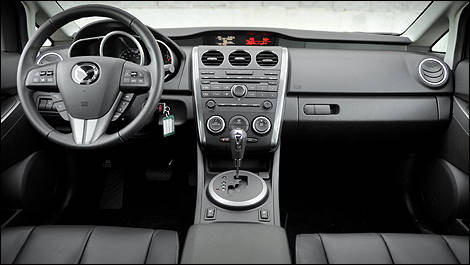I used to be an unquestioning supporter of the Mazda CX-7. This modern crossover once conquered my heart with its sleek silhouette, sporty dynamics and slightly more aggressive attitude than the average competitor.
The 2010 model, however, has somewhat put a damper on my love affair. Styling is still sharp; heck, designers even found a way to make it more refined and more visually attractive. It’s just that the proliferation of Mazdas on the road and the new engine’s less-than-pleasant behavior have taken away some of its cachet -- not all of it, though.
Revised exterior
Aesthetically speaking, the 2010 Mazda CX-7 sports a beautifully-executed design that refuses to age or fly under the radar. The flowing hood, bulging wheel arches and streamlined tail section once again work to create a sexy body.
Mazda even managed to integrate its new corporate image -- you know, the grinning front fascia -- without disfiguring the whole vehicle. In fact, I would go as far as to say that this broad smile makes the CX-7 look more assertive than ever before. By all accounts, this is arguably the lone successful application of the revised visual signature in the entire Mazda lineup.
Inside, a couple of minor changes have been performed. The mildly-updated dashboard, fit and finish turned out to be an easy solution to preserve the modern look of the cabin. Unfortunately, the seats fail to provide decent support for the thighs and lower back (I pity those taller than me). As a result, finding a comfortable driving position is difficult and long trips become relatively painful. On the plus side, rear-seat occupants enjoy ample room and reasonably-longer seat cushions.
As crossovers go, the CX-7 deserves praise for its cargo capacity, but not so much for its rear liftgate, which I found a bit heavy to manipulate and not quite low enough for easy access. Here, designers clearly sacrificed functionality in favor of styling. This doesn’t change the fact that the CX-7 can accommodate an average family’s cargo needs, though.
 |
| I used to be an unquestioning supporter of the Mazda CX-7. |
The 2010 model, however, has somewhat put a damper on my love affair. Styling is still sharp; heck, designers even found a way to make it more refined and more visually attractive. It’s just that the proliferation of Mazdas on the road and the new engine’s less-than-pleasant behavior have taken away some of its cachet -- not all of it, though.
Revised exterior
Aesthetically speaking, the 2010 Mazda CX-7 sports a beautifully-executed design that refuses to age or fly under the radar. The flowing hood, bulging wheel arches and streamlined tail section once again work to create a sexy body.
Mazda even managed to integrate its new corporate image -- you know, the grinning front fascia -- without disfiguring the whole vehicle. In fact, I would go as far as to say that this broad smile makes the CX-7 look more assertive than ever before. By all accounts, this is arguably the lone successful application of the revised visual signature in the entire Mazda lineup.
Inside, a couple of minor changes have been performed. The mildly-updated dashboard, fit and finish turned out to be an easy solution to preserve the modern look of the cabin. Unfortunately, the seats fail to provide decent support for the thighs and lower back (I pity those taller than me). As a result, finding a comfortable driving position is difficult and long trips become relatively painful. On the plus side, rear-seat occupants enjoy ample room and reasonably-longer seat cushions.
As crossovers go, the CX-7 deserves praise for its cargo capacity, but not so much for its rear liftgate, which I found a bit heavy to manipulate and not quite low enough for easy access. Here, designers clearly sacrificed functionality in favor of styling. This doesn’t change the fact that the CX-7 can accommodate an average family’s cargo needs, though.
 |
| The mildly-updated dashboard, fit and finish turned out to be an easy solution to preserve the modern look of the cabin. |




